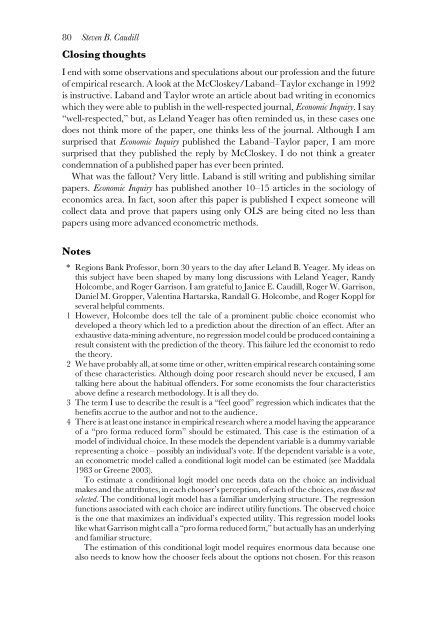Money and Markets: Essays in Honor of Leland B. Yeager
Money and Markets: Essays in Honor of Leland B. Yeager
Money and Markets: Essays in Honor of Leland B. Yeager
Create successful ePaper yourself
Turn your PDF publications into a flip-book with our unique Google optimized e-Paper software.
80 Steven B. CaudillClos<strong>in</strong>g thoughtsI end with some observations <strong>and</strong> speculations about our pr<strong>of</strong>ession <strong>and</strong> the future<strong>of</strong> empirical research. A look at the McCloskey/Lab<strong>and</strong>–Taylor exchange <strong>in</strong> 1992is <strong>in</strong>structive. Lab<strong>and</strong> <strong>and</strong> Taylor wrote an article about bad writ<strong>in</strong>g <strong>in</strong> economicswhich they were able to publish <strong>in</strong> the well-respected journal, Economic Inquiry. I say“well-respected,” but, as Lel<strong>and</strong> <strong>Yeager</strong> has <strong>of</strong>ten rem<strong>in</strong>ded us, <strong>in</strong> these cases onedoes not th<strong>in</strong>k more <strong>of</strong> the paper, one th<strong>in</strong>ks less <strong>of</strong> the journal. Although I amsurprised that Economic Inquiry published the Lab<strong>and</strong>–Taylor paper, I am moresurprised that they published the reply by McCloskey. I do not th<strong>in</strong>k a greatercondemnation <strong>of</strong> a published paper has ever been pr<strong>in</strong>ted.What was the fallout? Very little. Lab<strong>and</strong> is still writ<strong>in</strong>g <strong>and</strong> publish<strong>in</strong>g similarpapers. Economic Inquiry has published another 10–15 articles <strong>in</strong> the sociology <strong>of</strong>economics area. In fact, soon after this paper is published I expect someone willcollect data <strong>and</strong> prove that papers us<strong>in</strong>g only OLS are be<strong>in</strong>g cited no less thanpapers us<strong>in</strong>g more advanced econometric methods.Notes* Regions Bank Pr<strong>of</strong>essor, born 30 years to the day after Lel<strong>and</strong> B. <strong>Yeager</strong>. My ideas onthis subject have been shaped by many long discussions with Lel<strong>and</strong> <strong>Yeager</strong>, R<strong>and</strong>yHolcombe, <strong>and</strong> Roger Garrison. I am grateful to Janice E. Caudill, Roger W. Garrison,Daniel M. Gropper, Valent<strong>in</strong>a Hartarska, R<strong>and</strong>all G. Holcombe, <strong>and</strong> Roger Koppl forseveral helpful comments.1 However, Holcombe does tell the tale <strong>of</strong> a prom<strong>in</strong>ent public choice economist whodeveloped a theory which led to a prediction about the direction <strong>of</strong> an effect. After anexhaustive data-m<strong>in</strong><strong>in</strong>g adventure, no regression model could be produced conta<strong>in</strong><strong>in</strong>g aresult consistent with the prediction <strong>of</strong> the theory. This failure led the economist to redothe theory.2 We have probably all, at some time or other, written empirical research conta<strong>in</strong><strong>in</strong>g some<strong>of</strong> these characteristics. Although do<strong>in</strong>g poor research should never be excused, I amtalk<strong>in</strong>g here about the habitual <strong>of</strong>fenders. For some economists the four characteristicsabove def<strong>in</strong>e a research methodology. It is all they do.3 The term I use to describe the result is a “feel good” regression which <strong>in</strong>dicates that thebenefits accrue to the author <strong>and</strong> not to the audience.4 There is at least one <strong>in</strong>stance <strong>in</strong> empirical research where a model hav<strong>in</strong>g the appearance<strong>of</strong> a “pro forma reduced form” should be estimated. This case is the estimation <strong>of</strong> amodel <strong>of</strong> <strong>in</strong>dividual choice. In these models the dependent variable is a dummy variablerepresent<strong>in</strong>g a choice – possibly an <strong>in</strong>dividual’s vote. If the dependent variable is a vote,an econometric model called a conditional logit model can be estimated (see Maddala1983 or Greene 2003).To estimate a conditional logit model one needs data on the choice an <strong>in</strong>dividualmakes <strong>and</strong> the attributes, <strong>in</strong> each chooser’s perception, <strong>of</strong> each <strong>of</strong> the choices, even those notselected. The conditional logit model has a familiar underly<strong>in</strong>g structure. The regressionfunctions associated with each choice are <strong>in</strong>direct utility functions. The observed choiceis the one that maximizes an <strong>in</strong>dividual’s expected utility. This regression model lookslike what Garrison might call a “pro forma reduced form,” but actually has an underly<strong>in</strong>g<strong>and</strong> familiar structure.The estimation <strong>of</strong> this conditional logit model requires enormous data because onealso needs to know how the chooser feels about the options not chosen. For this reason
















